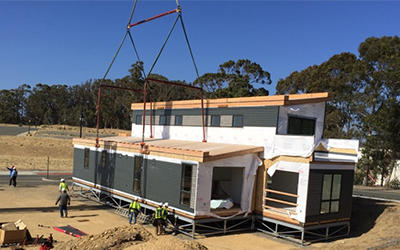
Written by: Alex Gray, President Sightline Building Solution
Building Sustainable and Resilient Homes in the North: Foundations and Site Preparation
Part 2 of our 12-part series on Northern and Remote Housing
Published: May 27, 2025
In Part 1 of our series, we outlined key principles for building in northern and remote communities: durability, adaptability, and energy efficiency. Now, in Part 2, we focus on one of the most critical aspects of northern construction—foundations and site preparation.
Harsh climate conditions such as permafrost, frost heave, drainage issues, and unstable soils demand tailored solutions. This article explores the challenges builders face, proven foundation strategies like Multipoint Systems, and essential best practices for site planning.
🧊 Understanding Northern Ground Conditions
Before selecting a foundation, it’s vital to understand the site-specific conditions. In many northern regions, the ground presents unique challenges:
Permafrost: Permanently frozen ground can thaw when exposed to building heat, causing significant structural shifts.
Seasonal Frost Heave: Freeze-thaw cycles cause soil to expand and contract, disrupting rigid foundations.
Drainage Issues: Poorly graded sites can trap water near or under the foundation, increasing frost risk and degradation.
Unstable Soils: Organic, silty, or sandy soils may compress or shift under load, demanding reinforced or floating foundation systems.
Geotechnical surveys are essential to guide foundation design, drainage strategies, and soil stabilization requirements.
🏗️ Recommended Foundation Systems
📏 Multipoint Foundations: Designed for the North
Multipoint Foundation Systems are engineered steel supports tailored for northern and remote construction. They offer:
Adjustability: Can be realigned over time as soil conditions change.
Low Site Impact: No excavation or concrete is needed—ideal for fragile ecosystems.
Ease of Transport and Installation: Lightweight, shippable components suit remote logistics.
Long-Term Durability: Corrosion-resistant steel ensures reliable performance in extreme conditions.
Multipoint systems are ideal in permafrost zones or where frost heave and limited access pose construction challenges.
🔄 Screw Piles
Screw piles are mechanically installed steel anchors that penetrate deep into the ground, providing a stable base despite shifting soils or frost heave. Their adjustability allows for minor realignments over time.
A geotechnical report should always be completed to determine proper pile depth and capacity. The building underside should be enclosed with pressure-treated plywood and fully sealed to prevent rodent entry and moisture exposure.
🏕️ Post and Beam / Pad and Post
In areas with stable soils and shallow frost depths, elevated systems like post and beam or pad and post offer simplicity and ventilation benefits. These raised designs promote airflow beneath the home, reducing moisture buildup and maintaining permafrost insulation.
🪨 ICF Foundations: Warm, Strong, and Frost-Protected
Insulated Concrete Forms (ICFs) combine EPS foam, steel rebar, and poured concrete into a highly insulated structural system. In Northern Ontario, ICFs are often enhanced with:
3″ XPS insulation on the exterior, with a dimple mat and peel-and-stick membrane for moisture protection
2″ XPS placed horizontally over footings to reduce frost penetration
Drain tile systems to divert water away from footings and prevent ground heave
With 1″ of rigid insulation equaling the thermal resistance of 12″ of soil, these systems provide outstanding frost protection. Always follow the National Building Code to determine footing depths based on permafrost levels in your region.
🌲 Site Selection and Preparation
Choosing the right site is just as critical as the foundation system itself. Key factors include:
Site Selection Best Practices
Elevation & Drainage: Build on higher ground to encourage runoff and minimize pooling.
Solar & Wind Orientation: Leverage natural shelter and sun exposure to improve thermal performance.
Permafrost Protection: Preserve surface vegetation to maintain natural ground insulation.
Site Preparation Steps
Clear Organic Material: Remove topsoil, vegetation, and organic debris to reduce moisture retention.
Gravel & Drainage Layers: Improve subsurface drainage with compacted gravel and French drains.
Soil Settlement Time: Allow filled or disturbed land to stabilize before construction begins.
Proper grading and subsurface drainage are vital to prevent frost-related damage over time.
🧰 Durable Materials for Cold-Climate Foundations
Northern builds demand robust materials engineered for moisture, temperature, and time. Recommended materials include:
Pressure-Treated Wood: Used in posts and beams for rot resistance.
Galvanized or Coated Steel: Used in Multipoint and screw pile systems for corrosion resistance.
Expanded or Extruded Polystyrene (EPS/XPS): Delivers reliable insulation in frost-protected slabs and ICFs.
Geotextile Fabric & Washed Gravel: Improve soil stability and drainage.
💧 Moisture Management Is Non-Negotiable
Water intrusion is one of the most common causes of foundation failure in cold climates. Moisture control measures include:
Grading the Site: Slope ground away from the home.
Perimeter Drain Tile: Direct groundwater away from footings.
Vapor Barriers & Waterproofing: Crucial for slab-on-grade or below-grade foundations.
Ventilation Under Raised Floors: Prevents mold and condensation in post-and-beam systems.
🏠 Case Studies from the North
Nunavut: In Arctic communities, traditional foundations failed due to permafrost thaw. Homes built on Multipoint and screw pile systems have remained stable, thanks to their flexibility and adaptability.
Northern Quebec: Where permafrost isn’t a concern but deep frost is, builders are using frost-protected slabs with rigid insulation. These systems offer cost-effective thermal performance and reduce frost heave.
🧭 Final Thoughts
Northern housing requires more than strong walls—it starts with a strong understanding of the ground beneath. The right combination of site selection, foundation type, and moisture management ensures that homes will stand the test of time in Canada’s most extreme climates.
Multipoint and screw pile systems are changing what’s possible for builders in the North. When paired with strategic planning and durable materials, these systems lay the groundwork for truly resilient homes.
➡️ Stay tuned for Part 3, where we’ll explore high-performance wall systems and insulation strategies for extreme climates.
Questions or project ideas? Visit our website or get in touch—we’re here to support better building in the North.

